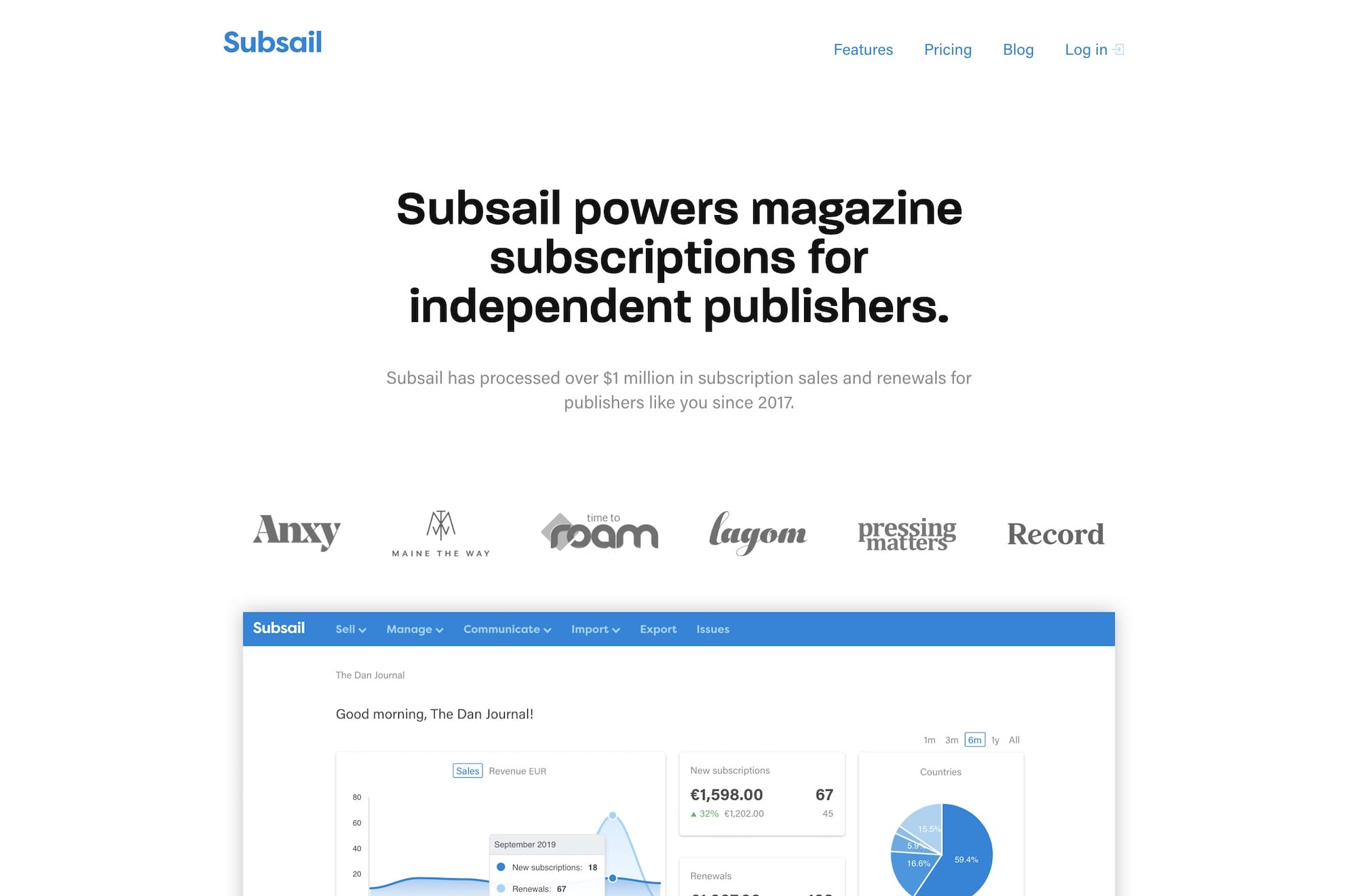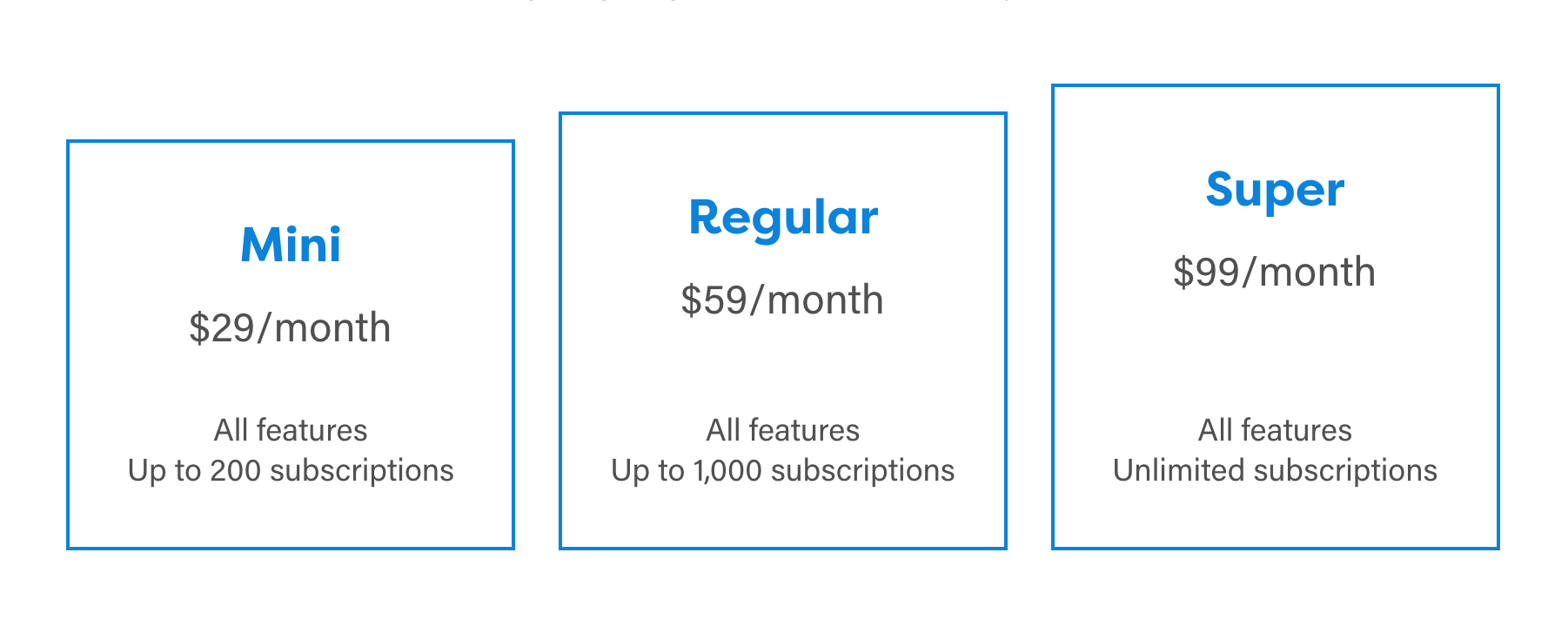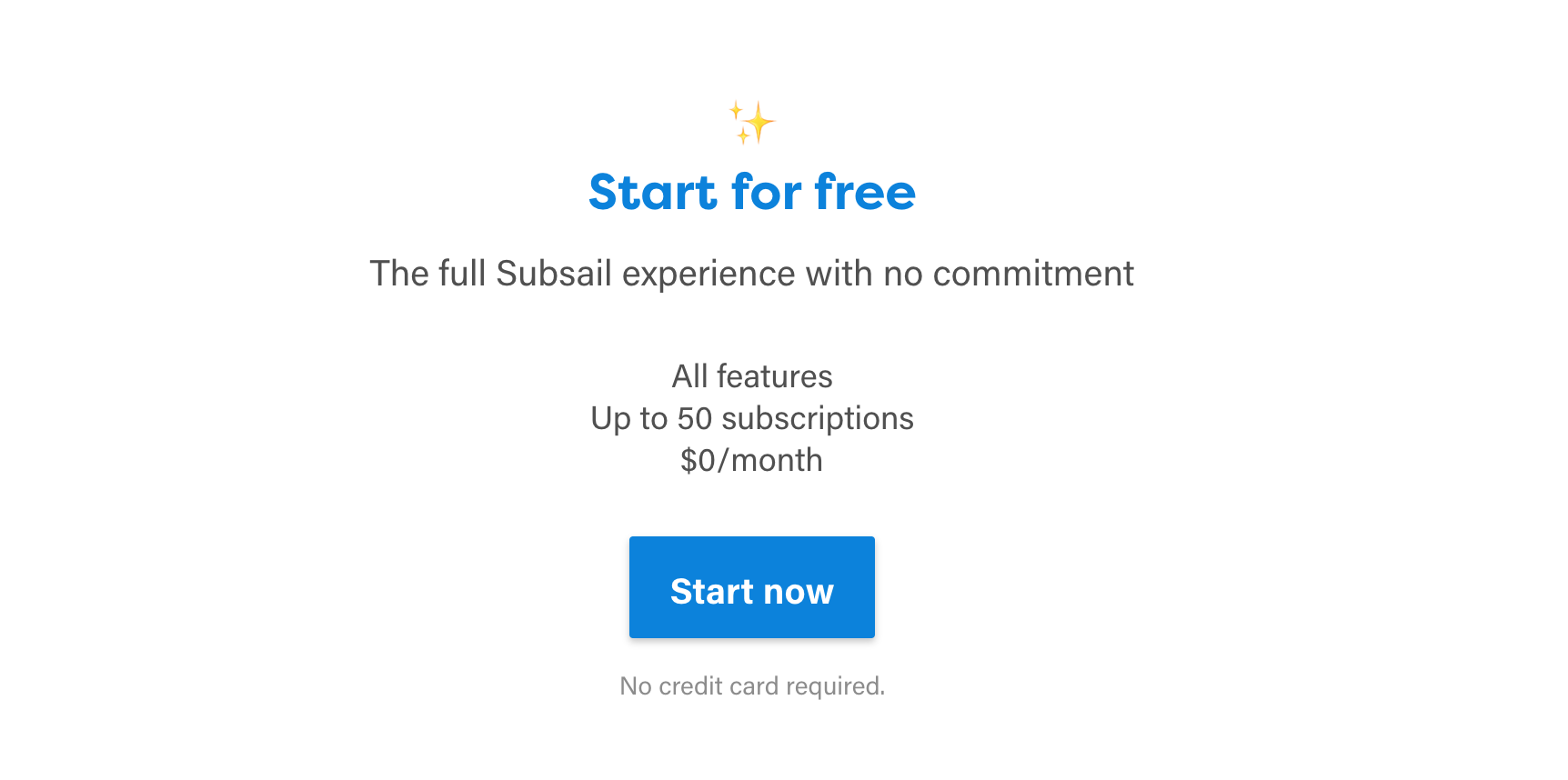Subsail’s pricing journey from usage-based to tiered pricing and back again
How I have changed and adapted pricing for my SaaS product, Subsail, over the past four years.

Preface
Subsail is an e-commerce platform I started in 2016 for indie magazines to run subscriptions. Since its public launch in Autumn 2017, publishers have processed $1.5m in subscription sales. It is currently still a side project and makes about 20% of my yearly income.
This post was originally posted on Subsail's old Medium blog in May 2017. I have edited and updated the content and added Subsail's latest pricing iteration at the end.
When I launched Subsail as a beta in 2016, I still didn’t really know how to price the product. This is a common problem with SaaS products. How do you price something that’s a) a brand new service, and b) code running on a server?

It is always a bit scary pricing a product like this, as you need a good balance of three things:
revenue, so you make enough money,
a reasonable price, so you don’t scare potential customers off purely based on a dollar amount,
and worth, so that you price perfectly against how useful the product is and the problem it solves (how much time, effort and money can be saved by using it).
Pay-per-subscription ☝
My initial thought was usage-based pricing. This would mean customers would only pay for what they used. A price of €2/subscription seemed like a decent price (which represented the amount it would cost to manage and maintain a single subscription for its lifetime).
As an example, if you had a subscriber base of 500, this averages out at gaining 41 new subscriptions every month. Your monthly fee would be, on average, about €80. Selling subscriptions at €30 would mean you’re only spending 7% of revenue on managing all of your subscriptions in Subsail, saving time and money in the process.
The idea was that €2 for every subscription added to your account would be added to the respective calendar month’s invoice, and you would be automatically charged at the end of the month through PayPal, using their Billing Agreement system.
Around the time this billing system went live, I was reading and researching about different pricing models and, combined with some early feedback, a flat monthly fee seemed more appropriate. Two major disadvantages to the usage-based model are unpredictable charges (you never really know what your bill will look like at the end of the month) and a complicated billing system, both for me to create and maintain, and for customers to use and understand.
Flat monthly fee 💵
Even though I was sold on changing to a simpler flat monthly fee, I found it much harder to come up with a number than with the usage-based fee. To be able to hit the mark across a range of publishers—some with 50 subscribers, some with 1,000—was incredibly hard. I settled on $59/month, with a full-featured 14-day trial.
I know this price knocked out a range of smaller publishers who make magazines in their spare time and don’t sell many subscriptions, making it a struggle to justify $59 a month to manage their subscriptions. The trade-off (which I was only semi content with) is that Subsail isn’t really necessary for tiny publishers; there is still a point at which spreadsheets still work OK-ish, and it’s much easier to send campaigns to subscribers from a small self-maintained list.
(I have no scientific proof of this, but talking to publishers and seeing how they manage their subscriptions, it seems that at somewhere between 50 and 100 subscriptions, the numbers get too much to handle using hacked-together systems and spreadsheets. Subsail exists to help once you hit this point.)
Still, I was convinced that there enough smaller publishers that would be put off completely by a $59 plan, so I introduced a smaller plan at $29/month, specifically aimed at publishers with smaller subscriber bases of up to 200 subscriptions. Which meant I had changed my pricing model once again again, to…

Tiered pricing 🚀
I see this as the best of both worlds. It’s like a mix of both usage-based and flat fee pricing. By offering different monthly prices for different-sized accounts, I could offer different-sized publications the exact same product (it’s very important for me that everyone gets the same features regardless of their size) but at more reasonable prices. Tiered pricing went live mid-May 2017.
The tiers
Mini $29/month (up to 200 subscriptions in their account)
Regular $59/month (up to 1,000 subscriptions)
Super $99/month (unlimited subscriptions)
(Every account has a 14-day full-featured trial to get to know the platform.)
Even with the Mini plan, the pricing is still geared towards most customers ending up on the Regular ($59) plan, but lets smaller publishers use Subsail without the perceived larger price tag. The Super plan is there purely for any big publishers that would blow the $59 price out of the water.
I was really happy with these plans and I’m glad I found a solid place regarding pricing.
Going freemium ✨
The next step in this pricing journey was the introduction of a completely free plan at the end of May 2017. I had used a free tier for a few years on the Magpile Store (a magazine marketplace where publishers sold directly to readers on Magpile.com, which I closed in 2018) but I hadn’t considered it for Subsail, purely because I was trying to keep things as simple as possible.

The new free plan for Subsail was enabled by default and allows up to 50 subscriptions to be added before a prompt to sign up to the Mini plan.
In my eyes, this is much better than a timed, 14-day trial, as it removes the stress of a time limit and therefore makes the experience of trying out the product more relaxed.
The freemium tiers
Free (up to 50 subscriptions)
Mini $29/month (up to 200 subscriptions)
Regular $59/month (up to 1,000 subscriptions)
Super $99/month (unlimited subscriptions)
Going freemium will hopefully let people feel more comfortable about signing up, trying the product as if they were a paying customer, and seeing for themselves just how helpful Subsail can be.
Usage-based pricing 📈
Towards the end of 2018, the platform was growing and I had multiple accounts processing $10k–20k in sales each month but only paying $99 for the opportunity to do so. This triggered me to think about how to price Subsail's plans more in tandem with how much value publishers were getting from the platform. This was to be the biggest pricing shift yet.
There was also a clear disconnect with some accounts based on the “total subscriptions sold” pricing method. A publisher may only have been selling $200 of new subscriptions per month but already over 1,000 subscriptions total, meaning they were paying for the $99/month Super plan.
It was clear that I needed to tie pricing closer to revenue, so I started to model in a spreadsheet—based on real sales data from a sample of accounts—a new pricing strategy based on a combination of a monthly and sales fee.
After trying out a range of different combos (higher monthly fee and lower sales fees, lower monthly fee and higher sales fee), I eventually settled on a new Regular plan at a reduced monthly rate of $49 plus 1% sales fee. I also removed the $99 Super plan completely.
This set up would mean any publisher on the $59 Regular plan would actually start paying less if they were processing less than $1,000 per month ($49 + 1% of $1,000 = $59), whereas I could easily charge the higher-grossing accounts more than $99 ($49 + 1% of $20,000 = $249) without it coming across as a crazy high monthly fee.
I also added a sales fee for the lower tier and created a new “Starter” plan at $29 + 1% to replace the $29 Mini plan.
At the same time as this change, I reduced the number of free subscriptions given on the free level, as a large proportion of publishers had been slow to reach the paid plan. My target was to get customers to a paid plan within 6 months; 50 subscriptions was skewing the average past that figure.
Removing the higher Super plan meant pricing is a lot easier to communicate. There are only two tiers and only two subscription limits for customers to keep in mind.
The usage-based tiers
Free (up to 20 subscriptions)
Starter $29/month + 1% sales (up to 100 subscriptions)
Regular $49/month + 1% sales
The new pricing went live in November 2018 for new customers. Existing paying customers were moved to the new plans in January 2019, but in the backend I made a special “Starter 200” plan for anyone who was still on the Mini plan, which preserved their original 200-subscription limit.
A new Mini plan
I was very happy with pricing during 2019, and how the usage-based pricing was better representing a customers' value from the platform.
However, I had a few potential customers saying that the $49 plan seemed too expensive. I also heard from a few paying customers that they were having slow periods between issues, meaning the monthly fee was too high and they were considering cancelling.
After some more pricing modelling, I decided to remove the $29+1% Starter plan—which offered a stepping stone for new customers before reaching the Regular plan—and instead offer a lower-priced monthly fee combined with a higher sales fee. This would allow publishers to pay less on slower months but I could still guarantee decent sales fees when they had larger months.
Both plans have the exact same features, so the only difference a customer has to choose between when signing up for a plan is the month and sales fees. I could have easily restricted the Mini plan feature-wise, as is common in other SaaS products, but I wanted to keep things as easy as possible.
I made this change for all new customers mid-2019. I grandfathered all customers on the Starter plans; they will continue to automatically upgrade to the Regular plan as they hit their subscription limits.
The updated usage-based tiers
Free (up to 20 subscriptions)
Mini $19/month + 5% sales
Regular $49/month + 1% sales
This was the first time Subsail had plans between which customers could downgrade, so I was nervous to make the change. So far, only those customers who were originally looking for a cheaper plan have made the switch. A handful of new customers have signed up on the Mini plan; interestingly, they seem happy paying a 5x higher sales fee to lock in the lower monthly fee, even though they would be better off on the Regular plan.
This concludes Subsail's pricing story over the past four years! I hope you have enjoyed reading through and perhaps have had some inspiration or got some ideas for your own products based on my exploration and changes.
The lessons I learned
One key lesson I have learned with all these pricing changes is that although it may seem like playing about with pricing may be annoying for customers, there has been very little negative feedback. A single customer complained about the introduction of a sales fees, but when I explained they would actually be saving money (their previous 6 months of sales meant their bills would have all been under the $59 flat fee they had been paying), they were happy again.
Updating and changing pricing may seem daunting but you have to keep working towards better profitability. I realised I could—and should—make more from my higher-selling customers, so I initiated a change that made that happen. And it worked out.
Just make sure any changes you make are well-communicated beforehand. I sent every paying customer an email over a month before I moved them to the sales fee plans and explained honestly why I was making the change. I even made sure to show how some of them would be saving money in that same email.
I also worked hard to make all the various plans manageable during transition. Every pricing change has meant I've had to create new plans in my billing software, and I currently still have customers on the Starter and "Starter 200" plans, even though they were retired over a year ago.
It's easy to get caught with a range of different plans and customers scattered across them. I've used the Regular plan over the years as my "default" plan, with the other plans all either automatically feeding into (Mini, Starter) or out of it (Super).
I'd be happy to help you
As a way to help other founders or anyone running a softtware product, I'd be happy to help you look at your pricing and offer any advice I can. Email me (hello at danrowden dot com) and I'll be happy to help.
Subscribe to the newsletter
Join 90+ members and get my new blog posts in your inbox.
Comments
Please subscribe or sign in to join the conversation!